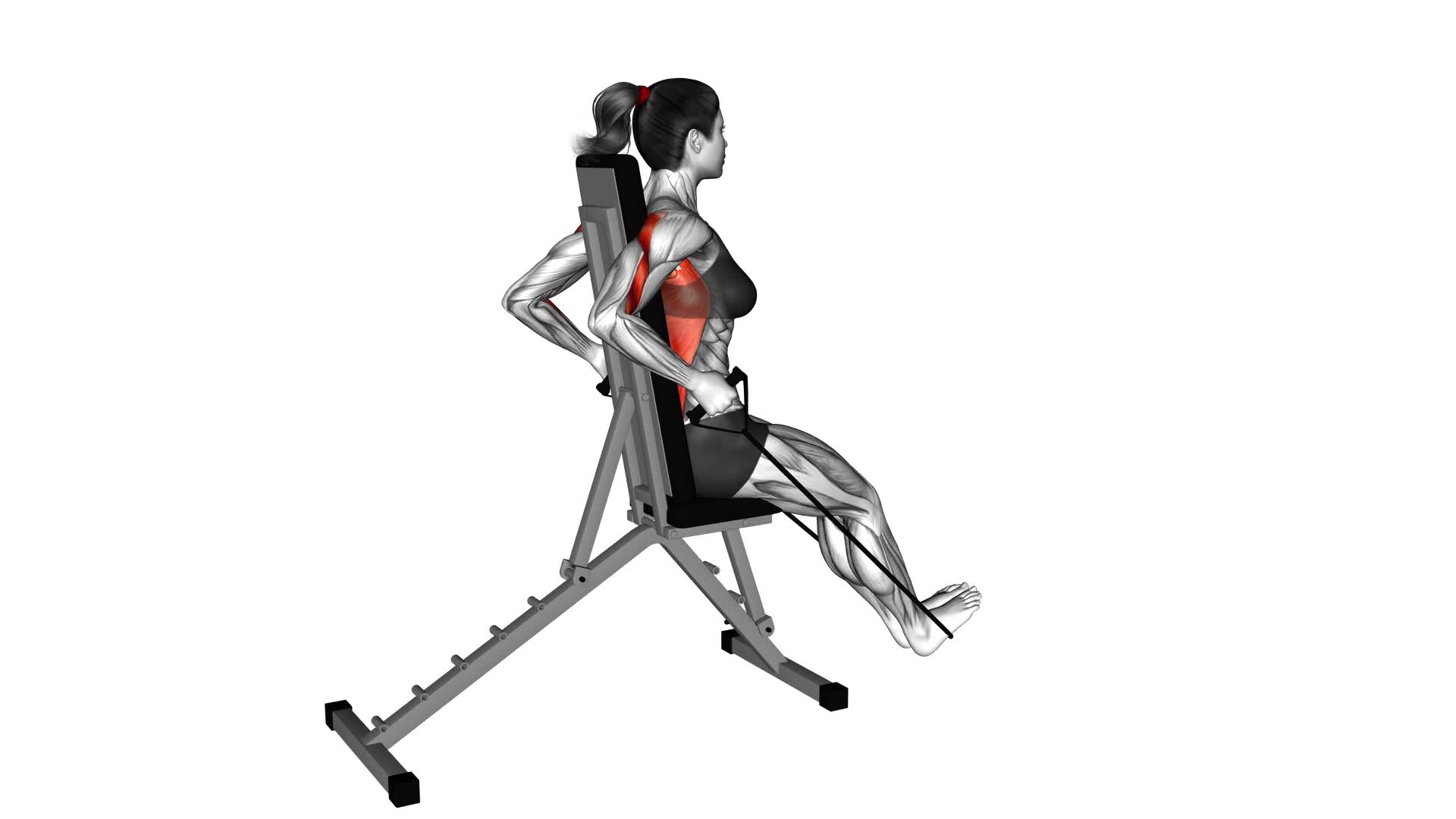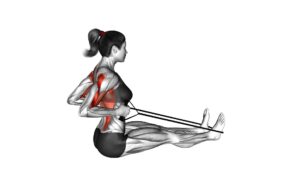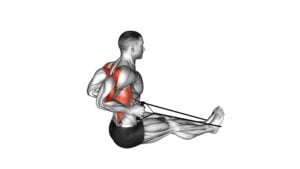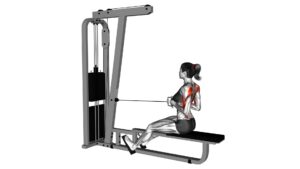Band Seated Straight Back Row (female) – Video Exercise Guide & Tips

Are you looking to strengthen your back muscles and improve your posture?
Watch This Exercise Video
The Band Seated Straight Back Row is the perfect exercise for you. In this video exercise guide, you'll learn the proper form and technique to maximize your results.
With variations for different fitness levels and tips to avoid common mistakes, you'll be able to incorporate this exercise into your workout routine with ease.
Get ready to feel stronger and more confident with the Band Seated Straight Back Row.
Key Takeaways
- Activates and strengthens back muscles
- Improves posture and reduces the risk of back pain and injury
- Engages core muscles for stability and support
- Increases muscle activation in arms
Benefits of the Band Seated Straight Back Row
To maximize your workout results, incorporate the band seated straight back row into your routine for its numerous benefits.
This exercise is highly effective in activating and strengthening your muscles. The band seated straight back row primarily targets your back muscles, including the rhomboids, traps, and lats. These muscles play a crucial role in maintaining good posture and supporting your spine. By performing this exercise regularly, you can improve your posture and reduce the risk of back pain and injury.
The band seated straight back row also engages your core muscles, providing stability and support during the movement. This helps to enhance your overall strength and balance. Additionally, this exercise increases muscle activation in your arms, specifically the biceps and forearms, as they work to pull the band towards your body.
Another benefit of the band seated straight back row is that it can be easily modified to suit your fitness level. You can adjust the resistance by using different bands or changing the distance between the band and your body. This allows you to progress gradually and challenge yourself as you get stronger.
Incorporating the band seated straight back row into your workout routine won't only help you build a strong and toned back but also improve your overall posture, stability, and strength. So, don't forget to include this exercise in your next workout session!
Proper Form and Technique for the Exercise
To perform the band seated straight back row exercise with proper form and technique, follow these steps:
- Sit on a chair or bench with your feet flat on the ground.
- Place a resistance band around your feet and hold the handles with an overhand grip.
- Keep your back straight and engage your core muscles.
- Pull the band towards your body by squeezing your shoulder blades together, while keeping your elbows close to your sides.
- Pause for a moment at the top of the movement, then slowly release back to the starting position.
Proper form and technique are crucial for maximizing the benefits of the band seated straight back row exercise. By maintaining a neutral spine and engaging your core, you can effectively target and strengthen the muscles in your upper back, shoulders, and arms. This exercise also helps improve posture and prevent back pain.
Modifications and variations can be made to suit your fitness level and goals. If you're a beginner, you can start with a lighter resistance band and gradually increase the intensity as you become stronger. For a more challenging workout, you can try using a wider grip or adding more resistance by doubling up the band or using a thicker one.
Now that you know the proper form and technique for the exercise, let's move on to the next section and learn about choosing the right resistance band for your fitness level.
Choosing the Right Resistance Band for Your Fitness Level
To choose the right resistance band for your fitness level, consider band strength recommendations based on your current strength and experience.
Start with a lighter resistance band if you're a beginner or have limited strength, and gradually progress to heavier bands as you become stronger.
It's important to challenge yourself without compromising your form or risking injury, so listen to your body and adjust the resistance level accordingly.
Band Strength Recommendations
What factors should you consider when choosing the right resistance band for your fitness level? Here are some important things to keep in mind:
- Your current strength level: Assess your overall strength and choose a band that provides enough resistance to challenge you without being too difficult to use.
- Exercise goals: Determine what you want to achieve with your band strength training. Different bands offer varying levels of resistance, so consider whether you want to focus on endurance, muscle building, or both.
- Band color or resistance level: Resistance bands often come in different colors or designated resistance levels. Choose a band that aligns with your current fitness level and goals.
- Progression potential: Select a band that allows for progression as you become stronger. Look for options that offer higher resistance levels or the ability to combine bands to increase intensity.
Considering these factors will help you choose the right resistance band for your fitness level and set you up for success in your resistance band exercises. As you become stronger, you can progress to higher resistance levels and continue challenging your muscles effectively.
Progressing Resistance Levels
Consider the factors that determine the appropriate resistance band for your fitness level when progressing to higher resistance levels.
As you advance in your strength and endurance, it's important to choose the right resistance band to continue challenging yourself and increasing the difficulty of your workouts. Progression techniques involve gradually increasing the resistance to ensure continuous improvement. When selecting a resistance band, take into account your current fitness level, the exercises you'll be performing, and your overall goals.
Opt for a band that provides enough resistance to challenge your muscles without compromising your form. It's essential to find a balance between difficulty and safety to avoid injury. Keep in mind that as you become stronger, you may need to switch to a higher resistance band to maintain progress and continue challenging yourself.
Modifications and Variations for Different Fitness Levels
For a more challenging workout, try incorporating different resistance levels and adjusting your seated position while performing the band seated straight back row exercise. Here are some modification options and advanced variations to suit different fitness levels:
- Increase Resistance: Use a band with higher tension to add more challenge to the exercise. This will engage your back muscles even more and help you build strength.
- Adjust Seated Position: Move closer to the anchor point of the band to increase resistance, or further away to decrease resistance. This allows you to customize the difficulty of the exercise based on your fitness level.
- Single-Arm Variation: Instead of using both arms simultaneously, try performing the exercise with one arm at a time. This will require more stability and core engagement, making it a more advanced variation.
- Bent-Over Variation: Instead of sitting upright, lean forward at your hips while keeping your back straight. This variation targets your back muscles from a different angle, providing a unique challenge.
Remember to always maintain proper form and listen to your body. Start with modifications that suit your current fitness level and gradually progress to more advanced variations as you become stronger.
Common Mistakes to Avoid During the Band Seated Straight Back Row
Are you making any common mistakes during the Band Seated Straight Back Row exercise? It's important to ensure that you're performing this exercise correctly to maximize its effectiveness and prevent injury. Here are some technique tips to help you avoid common mistakes.
One common mistake is using too much momentum. It's important to control the movement and avoid jerking or swinging your body. Instead, focus on using your back muscles to pull the band towards your body in a slow and controlled manner.
Another mistake is rounding your back. Make sure to maintain a straight back throughout the exercise. Imagine squeezing your shoulder blades together as you pull the band towards you. This will help engage your back muscles effectively.
Additionally, avoid pulling the band too far back. Overstretching can put unnecessary strain on your shoulders and back. Instead, aim to bring the band towards your torso, keeping your elbows close to your sides.
By avoiding these common mistakes and practicing proper technique, you can get the most out of the Band Seated Straight Back Row exercise.
Now, let's move on to the next section where we'll discuss tips for incorporating this exercise into your workout routine.
Tips for Incorporating the Band Seated Straight Back Row Into Your Workout Routine
To effectively incorporate the Band Seated Straight Back Row into your workout routine, it's crucial to focus on proper form and technique. Maintain a straight back, engage your core, and keep your shoulders relaxed throughout the exercise.
Additionally, varying the resistance levels of the band can help challenge your muscles and prevent plateaus in your training.
Proper Form and Technique
To perform the Band Seated Straight Back Row correctly, ensure that your back is straight and shoulders are engaged. Here are some tips to help you incorporate this exercise into your workout routine:
- Start by sitting on a bench or chair with your feet firmly planted on the ground.
- Place a resistance band around your feet and hold the handles in each hand.
- Keep your arms extended in front of you, with a slight bend in your elbows.
- Pull the band towards your body by squeezing your shoulder blades together, aiming to bring your hands towards your chest.
Remember, proper form and technique are essential for maximizing the benefits of this exercise and preventing injury. If you find the exercise too challenging, you can modify it by using a lighter resistance band or reducing the range of motion.
Incorporate the Band Seated Straight Back Row into your workout routine to strengthen your back and improve your posture.
Varying Resistance Levels
Choose the appropriate resistance level for the Band Seated Straight Back Row based on your fitness level and desired intensity. Different band tensions allow you to adjust the resistance levels to suit your needs and goals.
If you're a beginner or prefer a lighter workout, start with a band that offers less tension. As you progress and become stronger, you can increase the resistance by using a band with higher tension.
Adjusting the resistance levels is important to ensure that you're challenging your muscles and making progress in your strength training routine. Remember to listen to your body and choose a resistance level that allows you to perform the exercise with proper form and without straining.
Frequently Asked Questions
How Many Repetitions and Sets Should I Do for the Band Seated Straight Back Row?
To get the most out of the band seated straight back row, it's important to consider your repetition and set recommendations. While there's no one-size-fits-all answer, a good starting point is to aim for 8-12 repetitions and 2-3 sets. This will help you build strength and endurance in your back muscles. Remember, it's always important to listen to your body and adjust as needed.
Additionally, you can explore variations and modifications of this exercise to target different areas of your back.
Can the Band Seated Straight Back Row Help With Improving Posture?
The band seated straight back row is a great exercise for improving posture. By targeting the muscles in your upper back and shoulders, this exercise helps strengthen the muscles responsible for maintaining a straight back.
Additionally, band exercises offer unique benefits such as resistance throughout the entire range of motion, which can further enhance muscle engagement and promote better posture.
Incorporating the band seated straight back row into your routine can have a positive impact on your overall posture and alignment.
Is It Safe to Perform the Band Seated Straight Back Row if I Have a Previous Shoulder Injury?
If you have a previous shoulder injury, it's important to take precautions when performing the band seated straight back row. Make sure to consult with a healthcare professional or a certified trainer for guidance.
They can provide modifications that will help you perform the exercise safely and minimize the risk of aggravating your injury.
Can I Use a Resistance Band With Handles for This Exercise?
Yes, you can definitely use a resistance band with handles for the Band Seated Straight Back Row exercise. Using a resistance band with handles provides a convenient alternative to using a regular resistance band.
The handles allow for a better grip and can help you maintain proper form throughout the exercise. Additionally, using handles can provide added stability and control, making the exercise more effective in targeting your back muscles.
How Does the Band Seated Straight Back Row Target Different Muscles Compared to Other Rowing Exercises?
The band seated straight back row targets different muscles compared to other rowing exercises. It specifically works your back muscles, including the rhomboids, trapezius, and latissimus dorsi. By sitting and using a resistance band, you can isolate and strengthen these muscles effectively.
This exercise also helps improve your posture and upper body strength. There are various variations of rowing exercises, but the band seated straight back row offers unique benefits for targeting and toning your back muscles.
Conclusion
Incorporating the band seated straight back row into your workout routine can provide numerous benefits.
These benefits include improved posture, increased upper body strength, and enhanced muscle definition.
To maximize the effectiveness of this exercise, it's important to maintain proper form and technique.
Choosing the right resistance band is also key in getting the most out of this exercise.
Additionally, avoiding common mistakes will help ensure that you are performing the exercise correctly.
Whether you're a beginner or more advanced, modifications and variations allow you to tailor the exercise to your fitness level.
By adding the band seated straight back row to your routine, you can work towards a stronger and more toned back.

Author
Years ago, the spark of my life’s passion ignited in my mind the moment I stepped into the local gym for the first time. The inaugural bead of perspiration, the initial endeavor, the very first surge of endorphins, and a sense of pride that washed over me post-workout marked the beginning of my deep-seated interest in strength sports, fitness, and sports nutrition. This very curiosity blossomed rapidly into a profound fascination, propelling me to earn a Master’s degree in Physical Education from the Academy of Physical Education in Krakow, followed by a Sports Manager diploma from the Jagiellonian University. My journey of growth led me to gain more specialized qualifications, such as being a certified personal trainer with a focus on sports dietetics, a lifeguard, and an instructor for wellness and corrective gymnastics. Theoretical knowledge paired seamlessly with practical experience, reinforcing my belief that the transformation of individuals under my guidance was also a reflection of my personal growth. This belief holds true even today. Each day, I strive to push the boundaries and explore new realms. These realms gently elevate me to greater heights. The unique combination of passion for my field and the continuous quest for growth fuels my drive to break new ground.







